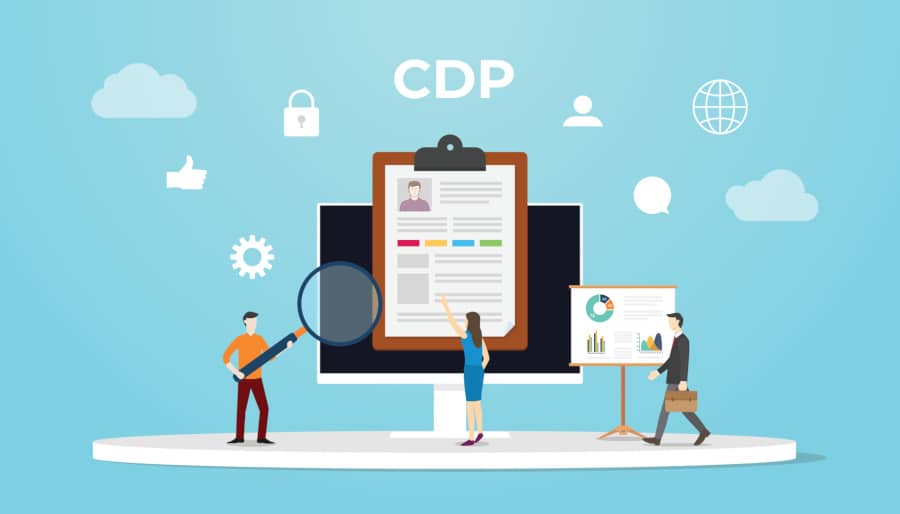These days, companies have a staggering amount of customer data at their disposal. However, without the right strategy and platform to manage it, this data can become a burden. That's where Customer Data Platforms (CDPs) come in. What is a CDP? What's the difference between a CDP, a CRM and a DPM? What are the benefits of a Customer Data Platform? Answers in this article.
What is a Customer Data Platform (CDP)?
A customer data platform (CDP) is a customer data management tool that enables you to centralize all the information you have on your customers in one place.
Using a CDP, you can aggregate data from different sources such as multi-channel interactions, purchases, newsletter subscriptions, external data and much more. You can also perform segmentation, predictive analysis and customer profiling based on this information. CDPs use complex data processing algorithms to help you better understand customer needs and behaviors, and personalize your interactions with them.
CDP will use data from all touchpoints (points of contact between the prospect and the company) such as Facebook, Google, website pages, emails and other places where they may interact with the organization.
The platform will collect all this data and make it actionable in a customer profile: you can then segment your targets in other systems like Facebook Ads or emailing.
The differences between CDP and other data management solutions
CDPs are often confused with other data management solutions such as Customer Relationship Management (CRM) or data analysis tools like a Data Management Platform (DMP). However, a CDP offers more advanced functionalities for collecting, analyzing and managing customer data.
CDPs are also designed to help companies personalize their customer interactions by using data processing algorithms for more accurate results.
Let’s look at the differences between these tools.
The differences between a CDP and a DMP
DMPs focus on advertising uses, particularly retargeting through the use of browser cookies. Information is often anonymous: it cannot be linked to a customer’s profile. A Data Management Platform uses data from third parties, which can therefore be exploited on an ephemeral basis. A CDP, on the other hand, keeps a history of customer interactions and adds new data as soon as a touchpoint is recorded.
The differences between CDP and CRM
CRM data, used to manage customer relationships, enables interaction based on conversational and purchase history. Although this tool is designed to store most customer information, it is not designed to store large volumes of data. It is first and foremost a sales tool. The CDP, on the other hand, connects to more data sources and is useful to several teams within the company: marketing, sales, support, product… This system provides a more complete view to improve the targeting and personalization of marketing actions.

5 advantages of a Customer Data Platform (CDP)
Since this tool is aimed at different teams within a company, it has many advantages, each different in nature and purpose. Discover five benefits of implementing CDP within your organization.
Customer data centralization
By storing all the company’s customer information in a single platform, it’s easier to gain an overview of their past interactions with the company.
The data gathered includes contacts, online and offline interactions, purchases and other relevant information, helping to better understand customer tastes and preferences.
Customer segmentation and profiling
This centralization provides a finer segmentation of different customer groups, making it easier to personalize interactions. The platform uses data on customer behavior to create customer profiles that take into account their entire history of interaction with the company.
This enables the company to identify habits and behavioral trends, and develop more targeted and relevant campaigns. As with CRM, CDP enables offers and promotions to be targeted at those customers most likely to find them interesting.
Predictive analysis and customer behavior modeling
Obtaining data from multiple sources is interesting. But using it concretely to drive growth in your business is useful. CDPs provide sophisticated tools for predicting future customer behavior, such as their next purchase and the type of purchases they make. Predictive analytics help to anticipate customer needs and preferences, so that personalized campaigns can be created based on these predictions.
Predictive behavior models also offer valuable insights into campaign performance, helping to fine-tune marketing strategies.
Integration with other marketing tools
CDPs can be connected to other marketing tools such as e-mail marketing, advertising platforms or social networks. This offers companies easy integration and better coordination of marketing efforts.
Consistency across all communication channels optimizes overall campaign performance.
Measure campaign effectiveness and make adjustments in real time
Using real-time data and analysis, CDPs help to measure the effectiveness of campaigns across different channels and make real-time adjustments to improve performance. These metrics can include conversion rates, response times and other performance indicators that can be accurately tracked in real time.
Customer Data Platform (CDP) at a glance
CDPs are an essential tool for any company wishing to better understand its customers and offer more effective, personalized interactions.
By using a CDP for tasks such as segmentation, personalization and predictive analysis, companies improve the processes of their marketing,
product and sales teams. With the benefits it offers, a customer data platform is a necessity in today’s digital environment.











